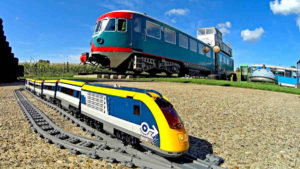CAN WE FIX IT? The ASX construction stocks fighting bankruptcy, materials and labour shortages to service massive forecast growth

Pic: Getty
- Supply chains are constrained globally as the world gets back on its feet
- This comes as inflation takes off, adding upward price pressures caused by scarcity of supply
- These conditions translate to major headwinds for contractors who agree to fixed price contracts
Global supply chain disruptions and material shortages, combined with rising freight and labour costs, are pushing up prices across a wide range of goods and services, which along with other factors are severely impacting the sustainability of the construction industry.
As Australia reopens and adjusts to a new COVID-19 reality, governments across all levels are relying on the construction industry to lead the economy forward with a record $218bn dollar pipeline of work reflecting a scale of investment, and the rate of growth to achieve it that has never been seen before.
According to Infrastructure Australia, demand for plant, labour, equipment, and materials to deliver the major public infrastructure pipeline over the next five years is forecast to be two-thirds higher than the previous five years (to 2019-20).
Sourcing material for construction projects such as glass, steel, and timber has become a problem as cost increases continue to surge due to the Russia/Ukraine conflict and international trade sanctions (Russia is one of the world’s largest exporters of soft timber, globally).
Jon Davies, chief executive officer at the Australian Constructors Association, says on top of the increased demand on the sector is the issue around industry capability and capacity to deliver that pipeline of work with a shortfall of 105,000 people expected over the next 18 months.
“That is important because if we don’t address that problem, we won’t be able to deliver that record pipeline of infrastructure and now with the floods we will see a greater demand on construction resources, particularly trade resources to fix the flood damage,” he said.
Construction companies go bust
More recently, the industry has seen the collapse of Queensland mid-tier builder, Condev, shortly after one of Australia’s largest construction companies, Probuild, plunged into administration while carrying out work on several high-profile residential apartment projects in Brisbane.
Fixed price contracts between developers, construction firms and sub-contractors are common – meaning builders adopt the risk of escalation in the cost of materials and downstream labour.
Historically, Davies said clients seek to get the lowest possible price with the maximum risk transfer, viewing that as value for money and thereby creating a pressure-cooker high-risk, low-margin construction industry.
“What that means is contractors assess and price in risk for extensive periods of time up to three or four years before the job is finished but if you went back two years ago now, most wouldn’t have thought about pandemic risk at the time,” he said.
Contractors take on that risk unwittingly thinking these types of situations won’t happen and when they do, it leads to significant increases in the cost of construction at a time when global supply chains are still impacted by COVID-19 and the rising cost of materials, Davies said.
“These issues with Probuild and Condev have highlighted how unsustainable the industry is,” Davies said.
“If contractors the size of Probuild can go bust then there’s obviously big systemic issues in the industry.”
Covid isn’t entirely to blame
While these issues have been exasperated by market uncertainty, Consult Australia CEO Nicola Grayson says the construction industry has some significant structural challenges which far predate COVID.
“Productivity is going backwards and if you think about it, that seems highly counterintuitive given we are in the middle of an unprecedented infrastructure boom – it just doesn’t add up,” Grayson explains.
“The reason for that is because we are, unfortunately, not delivering projects in the best way that we can and that is because we are not being collaborative enough, and we are not being sophisticated enough in our conversations around risk identification.”
Davies agrees.
“These challenges are nothing new but have come into increased focus because of that reliance on industry – there are some appalling statistics associated to the construction industry,” he says.
Currently, around 25% of all insolvencies in Australia occur in the construction space and women account for only 12% of the workforce. That number dips even further to 2–3% when discussing blue collar workers.
“Productivity growth in the construction industry has trailed other significant industries by 25 per cent over the last 30 years but if we could just halve that gap, we could be constructing an extra $15 billion of infrastructure every year for the same level of expenditure,” he said.
“In the run up to the federal election the budget is front and centre, we are talking about where we are going to save money and how we are going to get the budget back on track – how are we going to pay for things like Scomo’s $10 billion nuclear submarine base, but we could pay for that in one year if we got smarter about how we procure and deliver infrastructure.
“The opportunity is enormous and it’s an opportunity that is hiding there in plain sight.”
More construction companies could fold without major reform
With the industry’s weaknesses being made clear through a couple major collapses, there is significant concern this could become a trend unless reform takes places very rapidly.
“Most in industry have been expecting this to happen at some stage – companies can’t keep absorbing the loses they have been, and I wouldn’t be surprised if there are more to follow,” Grayson said.
This month, the Australian Constructors Association launched the Future of Australian Infrastructure Rating (FAIR) campaign, designed to rate government funded projects on how well they perform against a range of key areas to improve the sustainability of the industry such as improved productivity and increased innovation.
Federally funded projects undertaken by state government delivery agencies would be given a rating published on a website leading them to strive for increasingly better outcomes for their stakeholders.
Davies said the project would be given a score after they are finished on a scale of 1 to 10, based on whether they met reform targets during construction.
“Just like people who look at restaurant ratings, contractors would look at agency ratings when choosing where to focus their best resources providing another reason for delivery agencies to collaborate with industry to drive improved outcomes,” he said.
The Australian Constructors Association has made a pre-budget submission calling for the Federal Government to progress the initiative in partnership with industry.
Market outlook
Despite some very public failures, Euroz Hartleys research director and industrials analyst Gavin Allen says there is no reason why in good operating conditions contractors can’t make good money.
“There’s no reason to expect them to go broke either,” he said.
“I think the industry is profitable, but I think the key message is that it could be a lot more profitable once we get back into normal conditions.”
Here’s how ASX construction stocks are tracking:
| CODE | COMPANY | PRICE | 1 WEEK RETURN % | 1 MONTH RETURN % | 6 MONTH RETURN % | 1 YEAR RETURN % | MARKET CAP |
|---|---|---|---|---|---|---|---|
| BKW | Brickworks Limited | 22.9 | 6% | 6% | -9% | 22% | $3,307,191,696.77 |
| PKD | Parkd Ltd | 0.047 | 7% | -8% | -4% | -8% | $4,509,005.99 |
| FLX | Felix Group | 0.31 | 0% | -11% | 27% | 3% | $32,724,231.00 |
| SXE | Sth Crs Elect Engnr | 0.64 | 8% | 14% | -2% | 23% | $161,136,325.38 |
| AJL | AJ Lucas Group | 0.067 | -12% | 86% | 91% | 103% | $77,758,631.28 |
| EVZ | EVZ Limited | 0.175 | 0% | 13% | 3% | 40% | $16,339,844.78 |
| MND | Monadelphous Group | 11.25 | 3% | 1% | 21% | 7% | $1,049,194,568.03 |
| SRG | SRG Global Ltd | 0.625 | 10% | 15% | 24% | 32% | $274,164,795.23 |
| MAH | Macmahon Holdings | 0.1775 | -1% | 11% | -9% | -9% | $377,122,518.15 |
| DUR | Duratec | 0.37 | 1% | 12% | -3% | -24% | $87,727,662.40 |
| SND | Saunders Intl Ltd | 1.08 | 4% | 3% | 37% | 61% | $112,611,134.57 |
| CDX | Cardiex Limited | 0.41 | -9% | 3% | -34% | -41% | $44,806,132.75 |
| LYL | Lycopodium Limited | 5.99 | 8% | 12% | 32% | 13% | $237,249,149.22 |
| ITG | Intega Group Limited | 0 | -100% | -100% | -100% | -100% | $376,485,867.00 |
| ABC | Adbri Limited | 3.16 | 1% | 1% | -7% | 2% | $2,062,303,073.80 |
| ANG | Austin Engineering | 0.3 | 9% | 0% | 36% | 100% | $174,490,797.90 |
| MPP | Metro Perf.Glass Ltd | 0.38 | 0% | 0% | -16% | 21% | $70,443,672.68 |
| KNH | Koon Holdings | 0 | -100% | -100% | -100% | -100% | $186,531.84 |
| EMB | Embelton Limited | 11.6 | 0% | -11% | -7% | 1% | $25,031,141.20 |
| EGN | Engenco Limited | 0.535 | -6% | -1% | 16% | 5% | $168,790,296.87 |
| GNP | Genusplus Group Ltd | 1.21 | 1% | -5% | 19% | 26% | $208,263,856.90 |
| FBR | FBR Ltd | 0.029 | -6% | -19% | -19% | -47% | $70,435,383.11 |
| RDG | Res Dev Group Ltd | 0.062 | 3% | -5% | 17% | 29% | $174,227,208.62 |
| VMG | VDM Group Limited | 0.002 | 33% | 0% | 0% | -33% | $13,855,321.90 |
| OLH | Oldfields Holdings | 0.063 | 2% | 3% | -5% | -7% | $10,565,511.20 |
| SSM | Service Stream | 1.015 | 4% | 28% | 22% | -13% | $625,192,390.41 |
| ACF | Acrow Formwork | 0.51 | -2% | -1% | 28% | 38% | $129,725,139.18 |
| UOS | United Overseas Aust | 0.65 | -2% | -2% | -10% | -16% | $321,844,740.75 |
| ITG | Intega Group Limited | 0 | -100% | -100% | -100% | -100% | $376,485,867.00 |
| PGX | Primero Group | 0 | -100% | -100% | -100% | -100% | $100,363,480.92 |
| CIM | Cimic Group Ltd | 22.01 | 0% | 33% | 12% | 21% | $6,857,857,180.58 |
| PPK | PPK Group Limited | 5.65 | 12% | -7% | -72% | 3% | $505,377,398.38 |
| CSR | CSR Limited | 6.06 | 4% | 6% | 4% | 10% | $2,951,127,278.08 |
| BLD | Boral Limited | 3.385 | 3% | -7% | -8% | 5% | $3,750,500,624.60 |
| MGH | Maas Group Holdings | 4.71 | 0% | 7% | -12% | 43% | $1,395,346,069.92 |
| JLG | Johns Lyng Group | 8.62 | 4% | 15% | 38% | 124% | $2,249,813,242.32 |
| DCG | Decmil Group Limited | 0.2075 | -6% | -30% | -41% | -64% | $32,577,982.92 |
| DDB | Dynamic Group | 0.38 | -11% | -5% | -12% | -21% | $35,304,751.41 |
| NWH | NRW Holdings Limited | 2.18 | -1% | -2% | 31% | 8% | $992,717,701.30 |
| RWC | Reliance Worldwide | 4.16 | 1% | -13% | -22% | -6% | $3,357,902,751.25 |
| GWA | GWA Group Ltd | 2.24 | -3% | -7% | -15% | -22% | $607,319,708.77 |
| MXI | Maxiparts Limited | 2.19 | 5% | -18% | -32% | 61% | $107,117,179.32 |
Southern Cross Electrical Engineering (ASX:SXE)
For 44 years, SXE has operated in five key markets – mining, industrial, utilities and energy infrastructure, telecommunications and data centres, and commercial developments and public infrastructure.
Headquartered in Perth, the company offers the full range of capabilities including E&I Construction, E&I Services and Maintenance, and Communications.
Earlier this week its subsidiary Heyday received contract awards totalling $50mn in the commercial sector in Sydney for an electrical services design and construct contract by CPB Contractors for a 39-storey premium grade commercial tower which will be built above the north entrance to Sydney Metro’s Pitt Street Station.
ASX listed Australia Corporation also awarded Heyday the electrical and communications fit-out works for the Commonwealth Bank Place Sydney North Building.
Cimic Holdings (ASX:CIM)
Australian multinational contractor, CIM, has made headlines lately for not paying hundreds of millions of dollars to workers, subcontractors, and banks in its Middle East operations in a scandal dubbed a humanitarian disaster.
This comes as CIM’S largest shareholder – Spain’s ACS – placed a takeover bid totalling of $1.5bn, which is set to reduce its disclosure requirements and scrutiny.
NRW Holdings (ASX:NRW)
In February last year NRW acquired Primero Group – a vertically integrated EPC business that operates in the mineral processing, energy and non-process infrastructure market segments as a turnkey solution provider.
NRW’s business is structured into civil, mining, minerals, energy & technologies, and drill & blast, operated through group entities including NRW Civil and Mining, Golding Group, Primero, Action Drill and Blast, RCR Mining Technologies, DIAB Engineering and AES Equipment Solutions.
SRG Global (ASX:SRG)
SRG Global is an engineering-led global specialist asset maintenance, mining services and construction group operating across the entire asset lifecycle of engineer, construct and sustain.
Earlier this month SRG signed a sale implementation deed to acquire WBHO for $15.2 million – part of the WBHO Group, South Africa’s leading infrastructure contractor and the owners of Probuild.
SRG Global has worked with WBHO on several joint venture projects including most recently the award-winning Ocean Reef/Wanneroo Road Interchange in Western Australia.
Related Topics
UNLOCK INSIGHTS
Discover the untold stories of emerging ASX stocks.
Daily news and expert analysis, it's free to subscribe.
By proceeding, you confirm you understand that we handle personal information in accordance with our Privacy Policy.








